Archive for the ‘Robert Guy McCutchan’ Tag

Above: The Flag of The Episcopal Church
Photographer = Kenneth Randolph Taylor
+++++++++++++++++++++++++++++++++++++++++++++++
PETER CHRISTIAN LUTKIN (JR.) (MARCH 27, 1858-DECEMBER 27, 1931)
Episcopal Composer, Liturgist, and Music Educator
++++++++++++++++++++++++++++++++++++++++++
Dean Lutkin’s attitude to music was that of a high priest in the temple of a divine revealing art. He considered himself a steward of the mysteries of God and communicated to his pupils that high sense of a spiritual vocation which alone gives dignity and nobility to life.
–The Right Reverend George Craig Stewart, Bishop of Chicago, on Peter Lutkin; quoted in Robert Guy McCutchan, Our Hymnody: A Manual to The Methodist Church, 2nd. ed. (1937), 167
++++++++++++++++++++++++++++++++++++++++++
Peter Lutkin comes to this, A Great Cloud of Witnesses: An Ecumenical Calendar of Saints’ Days and Holy Days, via a plethora of hymnals.
Peter Christian Lutkin (Jr.), born in Thompsonville, Wisconsin, on March 27, 1858, came from a Danish-American family. The family moved to Chicago, Illinois, in 1869. Shortly thereafter, both parents–Peter Christian Lutkin (Sr.) and Hannah (Olivarious) Lutkin–died.
Our young saint made his way to fulfilling his potential with the help of many people, some of them related to him. Lutkin attended public schools in Chicago as well as the choir school at the Episcopal Cathedral of St. Peter and St. Paul. At the age of 14 years, he became the first boy contralto soloist in the Midwest. Lutkin worked as an instructor in piano at Northwestern University, which lacked a music department, in 1879-1881. He spent 1881-1884 studying music in Europe; a group of Chicago musicians had raised the funds to make those studies possible.
Lutkin, back in Chicago, made the most of his talents. He held overlapping portfolios:
- Organist and choirmaster, St. Clement’s Episcopal Church (1884-1891);
- Director of the Department of Theory, the American Conservatory of Music (1885-1895);
- Organist and choirmaster, St. James’s Episcopal Church (1891-1896);
- Founder and first Dean of the School of Music, Northwestern University (1896-1928);
- Musical Editor, The Methodist Hymnal (1905);
- Founder and Director of the North Shore Festivals (1908-1930);
- President, the Music Teachers’ National Association (1911, 1920); and
- Musical Editor, The (Episcopal) Hymnal 1916 (1918).
Our saint, a pioneer in college music education in the United States and a champion of choral a cappella music, also helped to found the American Guild of Organists in 1896. Syracuse University awarded Lutkin the Mus.D. degree in 1900.
Lutkin composed canticles, anthems, hymn tunes, and instrumental works. His hymn tunes included LANIER, THEODORE, PATTEN, and CARMAN. Perhaps his most anthem was The Lord Bless You and Keep You.
Lutkin, aged 73 years, died in Evanston, Illinois, on December 27, 1931. His widow was Nancy Leiah Carmen Lutkin (1861-1949), whom he married on October 27, 1885.
KENNETH RANDOLPH TAYLOR
SEPTEMBER 1, 2022 COMMON ERA
THE FEAST OF SAINT DIONYSIUS EXIGUUS, ROMAN CATHOLIC MONK AND REFORMER OF THE CALENDAR
THE FEAST OF DAVID PENDLETON OAKERHATER, CHEYENNE WARRIOR, CHIEF, HOLY MAN, AND EPISCOPAL DEACON AND MISSIONARY IN OKLAHOMA
THE FEAST OF SAINT FIACRE, ROMAN CATHOLIC HERMIT
THE FEAST OF FRANÇOIS MAURIAC, FRENCH ROMAN CATHOLIC NOVELIST, CHRISTIAN HUMANIST, AND SOCIAL CRITIC
+++++++++++++++++++++++++++++++++++++++++++++++
Holy God, whose majesty surpasses all human definitions and capacity to grasp,
thank you for those (especially Peter Lutkin)
who have nurtured and encouraged the reverent worship of you.
May their work inspire us to worship you in knowledge, truth, and beauty.
In the Name of the Father, and of the Son, and of the Holy Spirit. Amen.
1 Chronicles 25:1-8
Psalm 145
Revelation 15:1-4
John 4:19-26
KENNETH RANDOLPH TAYLOR
NOVEMBER 27, 2012 COMMON ERA
THE FEAST OF SAINT JAMES INTERCISUS, ROMAN CATHOLIC MARTYR
THE FEAST OF HENRY SLOANE COFFIN, U.S. PRESBYTERIAN THEOLOGIAN
+++++++++++++++++++++++++++++++++++++++++++++++
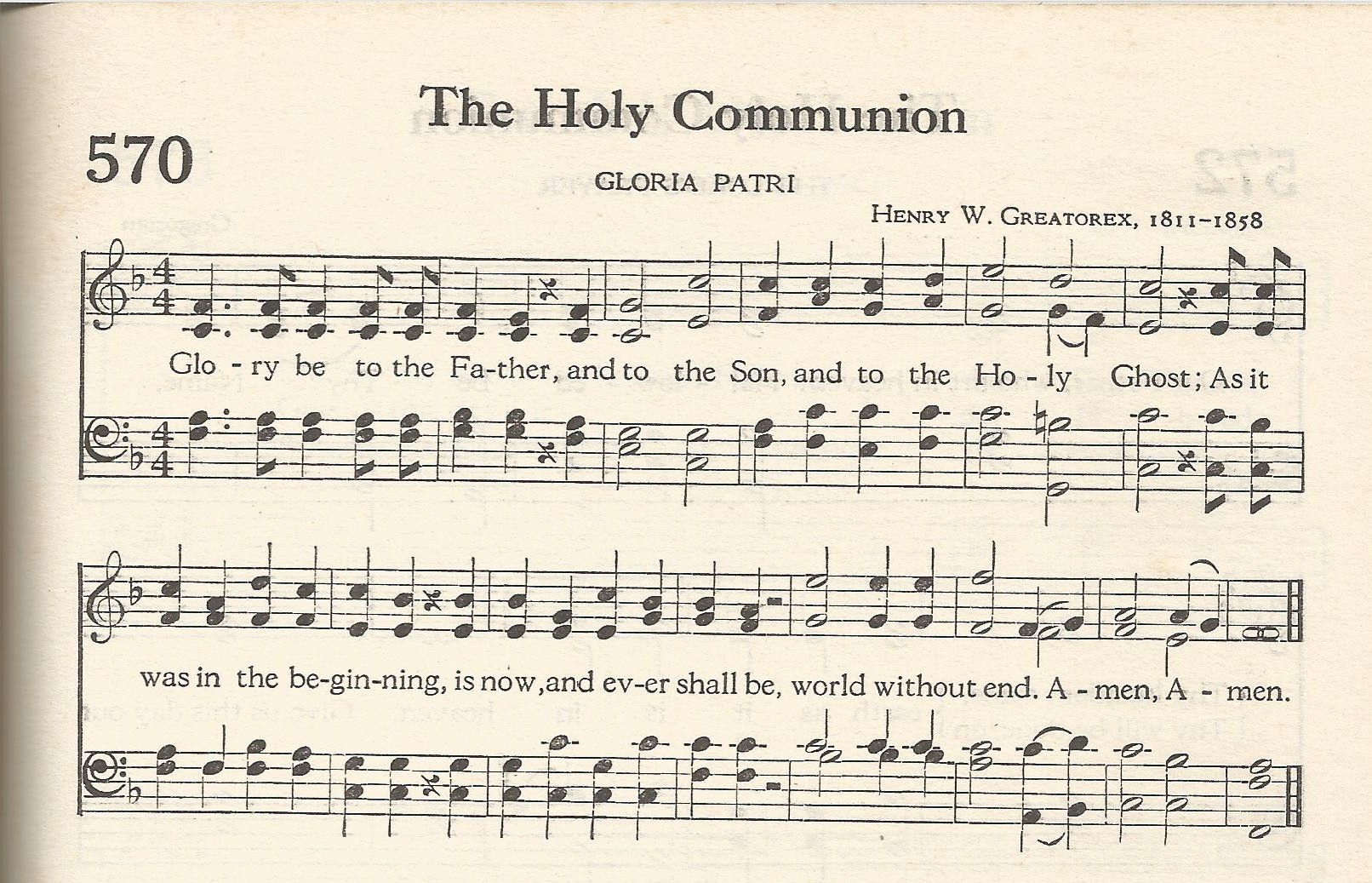
Above: Greatorex’s Gloria Patri
Scanned by Kenneth Randolph Taylor from The Methodist Hymnal (1935)
+++++++++++++++++++++++++++++++++++++++++++++++++++++++
HENRY WELLINGTON GREATOREX (DECEMBER 24, 1813-SEPTEMBER 18, 1858)
Anglican and Episcopal Organist, Choirmaster, and Hymnodist
Henry Wellington Greatorex comes to this, A Great Cloud of Witnesses: An Ecumenical Calendar of Saints’ Days and Holy Days, via The Methodist Hymnal (1935), The Hymnal (1941), and The Methodist Hymnal (1966). My main sources for this post are the companion volumes for those hymnals.
Henry, born in Burton-on-Trent, Staffordshire, England, on December 24, 1813, came from an illustrious family of church musicians. Our saint’s grandfather, Anthony Greatorex, was the organist at Burton-on-Trent, as well as the composer of the hymn tune BURTON. Our saint’s father, Thomas Greatorex, was the organist at Carlisle Cathedral. In 1819. Thomas became the organist at Westminster Abbey. He also composed hymn tunes (including TOTTENTAM), chants, and other church music. Furthermore, Thomas was a conductor. When he died, he was destined for a burial inside Westminster Abbey. Henry, born in Burton-in-Trent, site of the family’s country home, grew up there and in London. He also received a fine education, especially in church music.
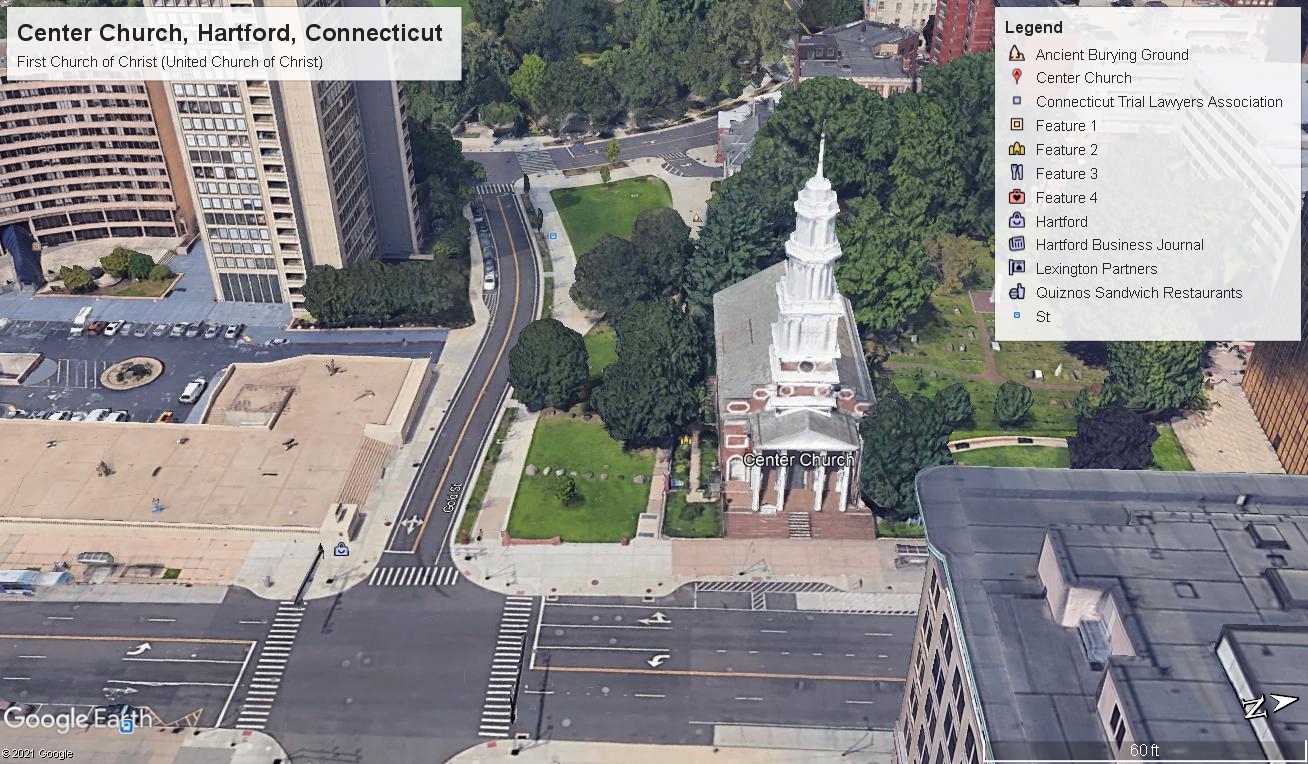
Above: Center Church, Hartford, Connecticut
Image Source = Google Earth
Henry moved to the United States in 1839. He had accepted an invitation to become the organist at Center Church (the First Church of Christ), Hartford, Connecticut. Our saint, who enjoyed living in Hartford, served as the organist of Center Church for about two years. After leaving Hartford and staying away briefly, he moved to West Hartford and became the organist at St. John’s Episcopal Church, recently founded.
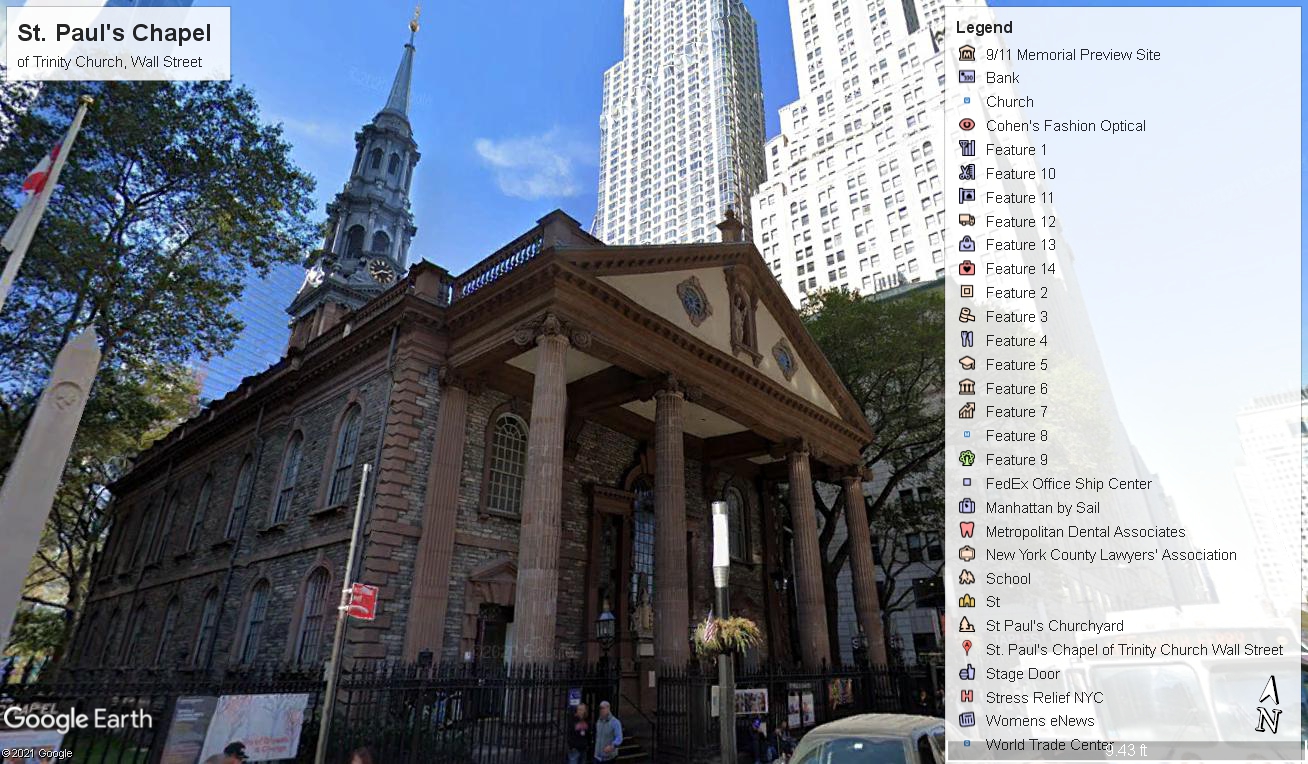
Above: St. Paul’s Chapel of Trinity Church, Wall Street, New York, New York
Image Source = Google Earth
In 1846, Henry transferred to St. Paul’s Chapel of Trinity Church, Wall Street, New York, New York, to work as the organist. After leaving St. Paul’s Chapel, our saint served as the organist-choirmaster of Calvary Episcopal Church, New York, New York. Then he relocated to Charleston, South Carolina, in 1853, to serve as an Episcopal Church organist. He died of yellow fever on September 18, 1858. He was 44 years old.
Our saint married twice. He married Frances (Samantha) Filley, of Windsor, Connecticut, while he worked in Hartford. Their son, Frank Henry Greatorex, born in New York, New York, had a fine singing voice, as did his father. Frank eventually settled in St. Augustine, Florida. Frank never knew his mother, who died shortly after his death. Henry married Eliza Pratt, a native of Ireland, as well as a Methodist preacher’s kid, in 1849. Eliza was a capable and world-famous sketch artist. She and our saint had three children–one son and two daughters. The daughters became activists, too. Eliza also had a fine contralto voice.
In 1851, Henry published A Collection of Psalm and Hymn Tunes, Chants, Anthems, and Sentences for the Use of the Protestant Episcopal Church in America, and For Congregations of Other Denominations, as Well as for Societies and Schools. This volume included an arrangement of the hymn tune SEYMOUR, as well as his original hymn tune MANOAH. The Collection also included an arrangement of the Gloria Patri. In all, thirty-seven compositions and arrangements in the Collection bore the initials “H. W. G.”
Robert Guy McCutchan (1877-1958), who valued good church music, held our saint’s Collection in high esteem. McCutchan wrote:
This book passed through many editions and generally had a wholesome effect on church music, especially in the larger cities.
—Our Hymnody: A Manual of The Methodist Hymnal (1937), 396
Henry’s death left Eliza a widow. She died in Paris, France, on February 9, 1897. She was 87 years old.
Our saint’s high standard in church music and indicated his reverence. It was a standard many church musicians would still do well to emulate. In the Preface to the Collection, Henry wrote:
The Editor of this work trusts that the following pages will be found generally useful in the service of the church. His aim has been to furnish good music, rather than light, frivolous melody–to restore, as nearly as practicable, the old standard tunes and chants to their original harmonies, while, in the selection of the new, he has endeavored to avoid vulgarity, or straining after effect.
–Quoted in Our Hymnody (1937), 396
KENNETH RANDOLPH TAYLOR
MARCH 24, 2021 COMMON ERA
THE FEAST OF OSCAR ROMERO, ROMAN CATHOLIC ARCHBISHOP OF SAN SALVADOR; AND THE MARTYRS OF EL SALVADOR, 1980-1992
THE FEAST OF SAINT DIDACUS JOSEPH OF CADIZ, CAPUCHIN FRIAR
THE FEAST OF PAUL COURTIER, APOSTLE OF CHRISTIAN UNITY
THE FEAST OF THOMAS ATTWOOD, “FATHER OF MODERN CHURCH MUSIC”
THE FEAST OF WILLIAM LEDDRA, BRITISH QUAKER MARTYR IN BOSTON, MASSACHUSETTS BAY COLONY, 1661
+++++++++++++++++++++++++++++++++++++++++++++++++++++++
Holy God, whose majesty surpasses all human definitions and capacity to grasp,
thank you for those (especially Henry Wellington Greatorex)
who have nurtured and encouraged the reverent worship of you.
May their work inspire us to worship you in knowledge, truth, and beauty.
In the Name of the Father, and of the Son, and of the Holy Spirit. Amen.
1 Chronicles 25:1-8
Psalm 145
Revelation 15:1-4
John 4:19-26
KENNETH RANDOLPH TAYLOR
NOVEMBER 27, 2012 COMMON ERA
THE FEAST OF SAINT JAMES INTERCISUS, ROMAN CATHOLIC MARTYR
THE FEAST OF HENRY SLOANE COFFIN, U.S. PRESBYTERIAN THEOLOGIAN
+++++++++++++++++++++++++++++++++++++++++++++++++++++++
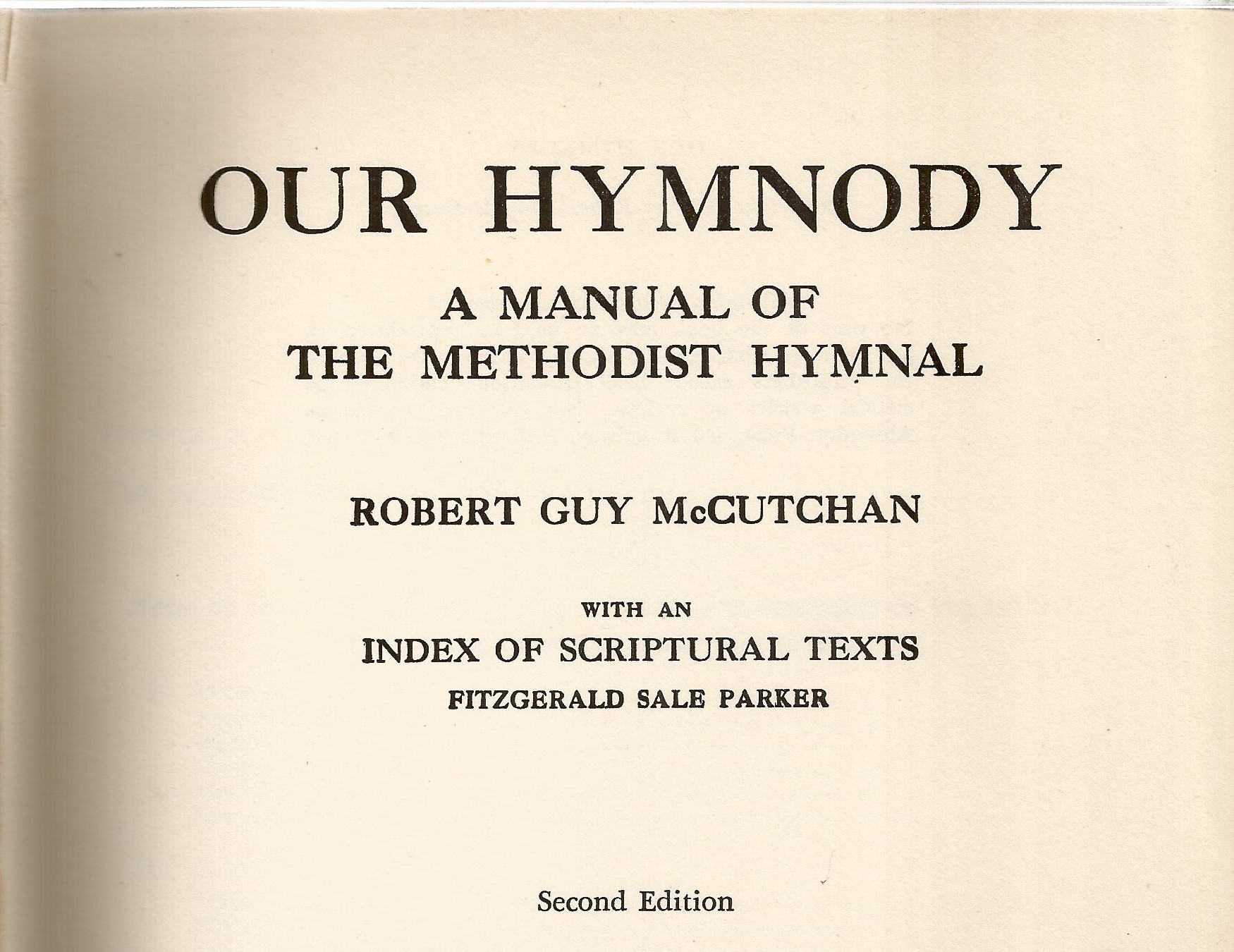
Above: Part of the Title Page of Our Hymnody (1937)
Scan by Kenneth Randolph Taylor
++++++++++++++++++++++++++++++++++++++++++++++++
ROBERT GUY MCCUTCHAN (SEPTEMBER 13, 1877-MAY 15, 1958)
U.S. Methodist Hymnal Editor and Hymn Tune Composer
Pseudonym = John Porter
Robert Guy McCutchan comes to this, A Great Cloud of Witnesses: An Ecumenical Calendar of Saints’ Days and Holy Days, via The Methodist Hymnals of 1935 and 1966.
McCutchan was one of the great American hymnodists. He made his mark in the field of hymnal companion volumes with Our Hymnody (1937), the companion to The Methodist Hymnal (1935). This hymnal companion volume has earned its reputation as the first substantial work in its genre in the United States. The book, at 619 pages long, indicated meticulous attention to details. It may have been the most detailed and thoroughly researched hymnal companion volume in the United States until the companion to The Hymnal (1941) of the Evangelical and Reformed Church. Armin Haeusslder’s The Story of Our Hymns (1952) was 1902 pages long. Since then, the four-tome companion to The Hymnal 1982 (1985) of The Episcopal Church may have claimed the title of the most thorough hymnal companion.
Carlton R. Young, writing in Companion to the Hymnal (1970), the mate of The Methodist Hymnal (1966), issued his evaluation of our saint:
McCutchan’s motto might well have been the first line of the hymn “Let all the world in every corner sing.” He devoted himself to bringing hymns into men’s lives.
–605
McCutchan, born in Mount Ayr, Iowa, on September 13, 1877, spent his life in music. He studied at Park College, Parkville, Missouri, then at Simpson College, Indianola, Iowa (B.M., 1904). In 1904, our saint began to teach voice at Baker University, Baldwin College. He also founded the conservatory at that institution of higher education. After teaching music privately in Berlin and Paris in 1911, McCutchan returned to the United States. He, the Dean of the School of Music (1911-1937) at DePauw University (1911-1937), served under future bishops Francis J. McConnell (1871-1953; President, 1909-1912) and G. Bromley Oxnam (1891-1963), President from 1928 to 1936. McCutchan retired in 1937.
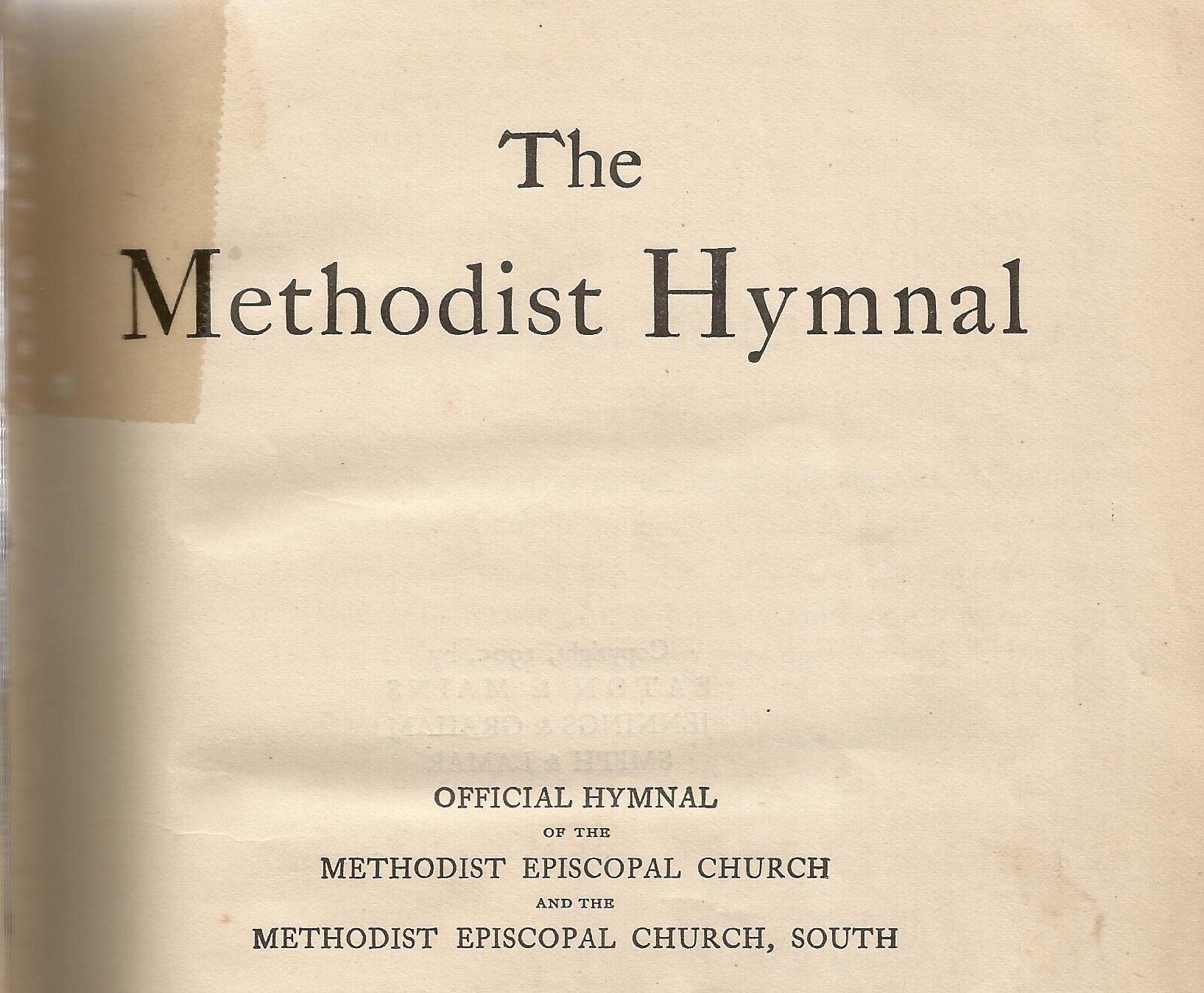
Above: Part of the Title Page of The Methodist Hymnal (1905)
Scan by Kenneth Randolph Taylor
The time for Methodist hymnal revision had come around again. Decades had passed since the publication of The Methodist Protestant Church Hymnal (1901) and The Methodist Hymnal (1905). The hymnal of 1905 had been a joint project of the Methodist Episcopal Church and the Methodist Episcopal Church, South. Steps toward the new hymnal started in 1928. In 1931, in the depths of the Great Depression, the three denominations cooperated on a joint hymnal. That year, McCutchan also became the editor.
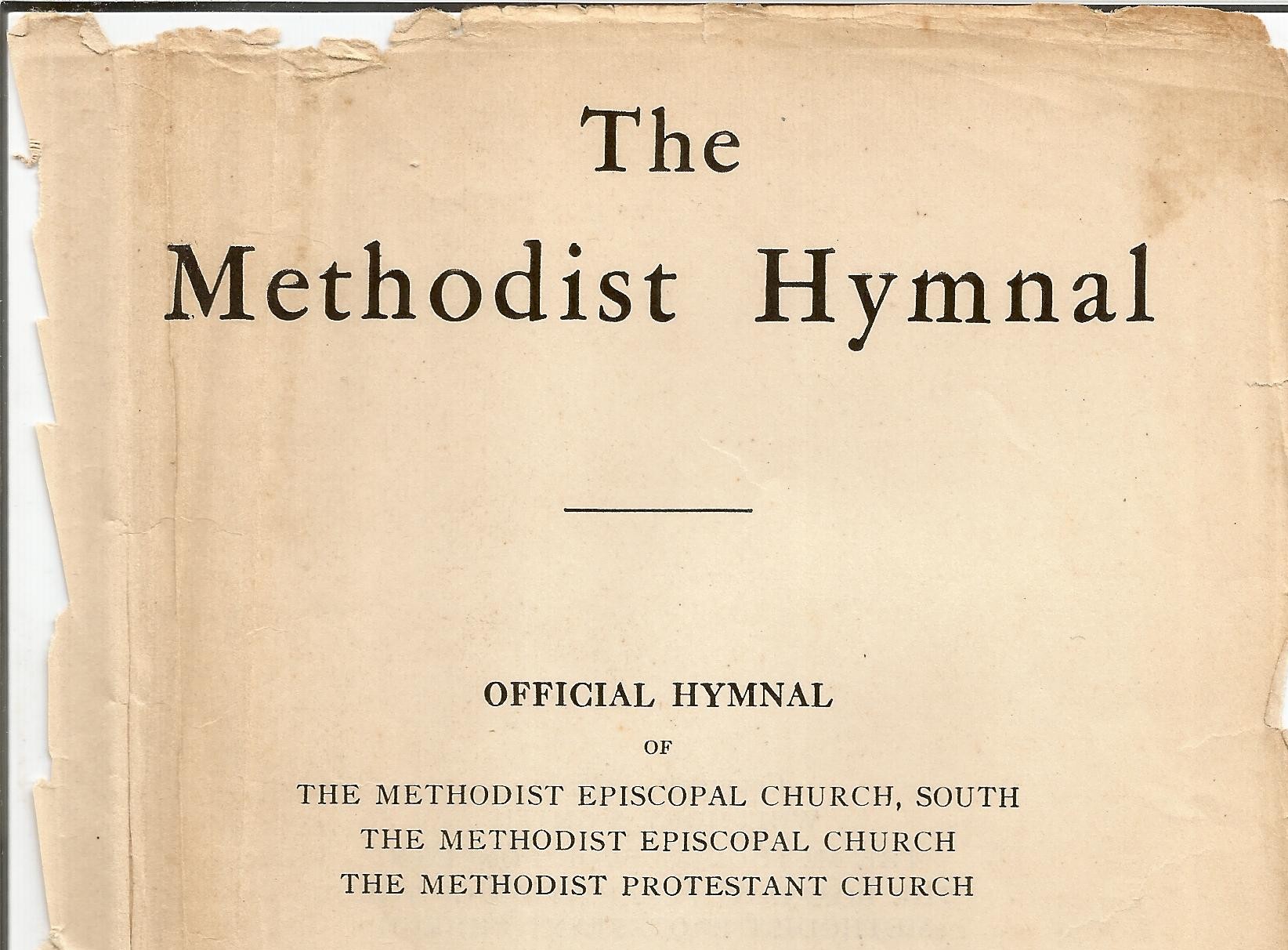
Above: Part of the Title Page of The Methodist Hymnal (1935) Prior to the Merger of 1939
Scan by Kenneth Randolph Taylor
McCutchan had his bona fides. He had collaborated on Better Music in Our Churches (1925) and Music in Worship (1927). Our saint had also served as the music editor of the American Junior and Church School Hymnal (1928). And he had written monographs and articles. Furthermore, McCutchan had composed three hymn tunes (FOWLER, DEPAUW, and OXNAM) and two responses (“The Beatitudes of Our Lord” and “Thy Testimonies are Very Sure”), which he eventually included in The Methodist Hymnal (1935).
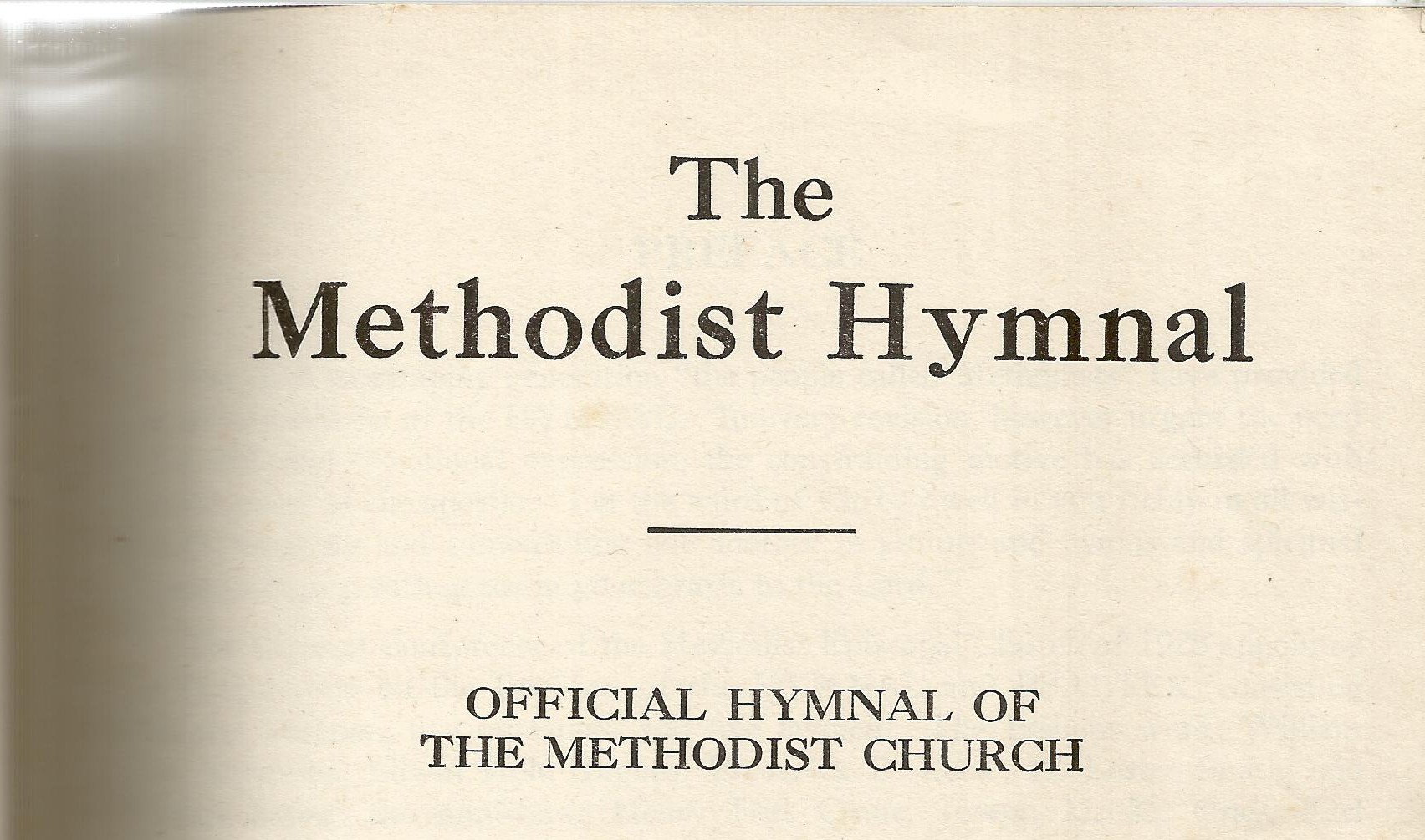
Above: Part of the Title Page of The Methodist Hymnal (1935) After the Merger of 1939
Scan by Kenneth Randolph Taylor
McCutchan had a strong sense of propriety. While serving as the hymnal editor, he composed three more hymn tunes (ALL THE WORLD, MASEFIELD, and TIPLADY) and another response (“O Worship the Lord in the Beauty of Holiness). These, included in The Methodist Hymnal (1935), bore the alleged name of the composer: John Porter, born in 1877. In Our Hymnody (1937), McCutchan wrote:
“John Porter” is the nom de plume if a hymn-writer who prefers to remain anonymous.
–32
Elsewhere, McCutchan explained:
It simply would not do for it to be known that the editor was their composer.
–Quoted in Carlton R. Young, Companion to the Hymnal (1970), 605
McCutchan also harmonized the hymn tune CAMPMEETING, found in The Methodist Hymnal (1966) and The United Methodist Hymnal (1989).
McCutchan’s subsequent publications included:
- Aldersgate, 1738-1938 (1938),
- Hymns in the Lives of Men (1945),
- Hymns of the American Frontier (1950), and
- Hymn Tune Names: Their Sources and Significance (1957).
McCutchan, as a hymnologist, was ecumenical and down-to-earth. He was a Methodist, of course, and he spent much time thinking about the realities of music in churches ranging from rural, wood-frame structures to Gothic buildings in urban settings. His work entailed collecting many American hymnals and song books–more than a thousand at the time of this death. He bequeathed that collection to the associated colleges at Claremont, California. And McCutchan devoted much time to music in Adventist, Brethren, and Congregationalist churches, too. He devoted his life to helping worshipers in churches sing great hymns.
McCutchan suffered from cancer during his final years. His wit, according to his widow,
came to his aid and those who cared for him through all the difficult days.
–Quoted in Young, Companion to the Hymnal (1970), 606
McCutchan, aged 80 years, died in Claremont, California, on May 15, 1958. His first wife, Carrie, had predeceased him.
McCutchan spent his life well, in the service of God. He spent that life in the field of hymnody.
Hymns, being sung theology, have long been crucial to the faith of many Christians. St. Paul the Apostle quoted a portion of a hymn in Philippians 2:6-11. Many people have matched the words and tunes of hymns they have used to renew their faith. And many have derived spiritual highs from wonderfully-composed and beautifully-performed descants. McCutchan’s contribution to church music and his grasp of hymnody mattered greatly.
KENNETH RANDOLPH TAYLOR
MARCH 19, 2021 COMMON ERA
THE FEAST OF SAINT JOSEPH OF NAZARETH, HUSBAND OF MARY, MOTHER OF GOD
++++++++++++++++++++++++++++++++++++++++++++++++
Holy God, whose majesty surpasses all human definitions and capacity to grasp,
thank you for those (especially Robert Guy McCutchan)
who have nurtured and encouraged the reverent worship of you.
May their work inspire us to worship you in knowledge, truth, and beauty.
In the Name of the Father, and of the Son, and of the Holy Spirit. Amen.
1 Chronicles 25:1-8
Psalm 145
Revelation 15:1-4
John 4:19-26
KENNETH RANDOLPH TAYLOR
NOVEMBER 27, 2012 COMMON ERA
THE FEAST OF SAINT JAMES INTERCISUS, ROMAN CATHOLIC MARTYR
THE FEAST OF HENRY SLOANE COFFIN, U.S. PRESBYTERIAN THEOLOGIAN
++++++++++++++++++++++++++++++++++++++++++++++++
++++++++++++++++++++++++++++++++++++++++++++++++

Above: Part of the Title Page of a Germane Volume from my Library
+++++++++++++++++++++++++++++++++++++++++++++++++++++++++++++++++++++++++
CALVIN WEISS LAUFER (APRIL 16, 1874-SEPTEMBER 21, 1938)
U.S. Presbyterian Minister and Hymnodist
Using The Hymnal (1933) has proven to be quite a boon to the Ecumenical Calendar of Saints’ Days and Holy Days. This source has yielded many wonderful discoveries already. And I have eight months’ worth of saints yet to go!
Among those discoveries (from my perspective) is the Reverend Calvin Weiss Laufer (1874-1938), a native of Brodheadsville, Pennsylvania. He attended Franklin and Marshall College, Lancaster, Pennsylvania (B.A., 1897; M.A., 1900) then Union Theological Seminary. Our saint, ordained in 1900s, served at two churches:
- Steinway Reformed Church, Long Island City, New York (1901-1905), and
- First Presbyterian Church, West Hoboken, New Jersey (1905-1915).
Then Laufer worked for arms of the Presbyterian Church in the U.S.A. for the rest of his life. From 1915 to 1924 he labored for the Presbyterian Board of Publication and Sabbath-School Work. Then, from 1925 until his death, he worked for the Presbyterian Board of Christian Education, focusing on musical publications. Our saint, in his official capacity, was partially responsible for the following books:
- The Church School Hymnal for Youth (1927);
- Junior Church School Hymnal (1928);
- Songs for Men (1928);
- Primary Music and Worship (1930); and
- Hymn Lore (1932);
- The Hymnal (1933);
- Handbook to the Hymnal (1935); and
- When the Little Child Wants to Sing (1935).
Laufer, a protege of Lewis Fitzgerald Benson, produced other volumes:
Our saint wrote hymns, some of which I have added to my GATHERED PRAYERS weblog. He wrote “We Thank Thee, Lord, Thy Paths of Service” (1919) for use in the Flatbush Presbyterian Church, Brooklyn, New York, New York, in September 1919. The pastor, Herbert H. Field, was a dear friend with whom Laufer dined weekly. Laufer wrote the triumphant “Thee, Holy Father, We Adore” (1931) in the midst of grief. Our saint wrote of those circumstances in the Handbook to The Hymnal (1935):
This triumphant and joyous hymn of faith was born out of a great domestic sorrow that left the author’s heart and home bereft of an inspiring companionship. The experience of God’s grace, in its ministry of comfort and a sense of victory in this soul crisis, not only illumined the darkness that fell but revealed the majesty and greatness of God in unforgettable glory.
–Page 19
And Laufer wrote “O Thou Eternal Christ of God” (1933) after an especially memorable Palm Sunday service.
Robert Guy McCutchan, editor of Our Hymnody: A Manual of The Methodist Hymnal, 2d. Ed. (Nashville, TN: Abingdon Press, 1937), wrote of our saint:
A writer of hymns, a devotional poet, and a musician of attainment, Doctor Laufer has made a notable contribution to the Church at large.
–Page 164
Yes, Dr. Laufer did.
KENNETH RANDOLPH TAYLOR
AUGUST 30, 2013 COMMON ERA
THE FEAST OF CHARLES CHAPMAN GRAFTON, EPISCOPAL BISHOP OF FOND DU LAC
+++++++++++++++++++++++++++++++++++++++++++++++++++++++++++++++++++++++++
Holy God, whose majesty surpasses all human definitions and capacity to grasp,
thank you for those (especially Calvin Weiss Laufer)
who have nurtured and encouraged the reverent worship of you.
May their work inspire us to worship you in knowledge, truth, and beauty.
In the Name of the Father, and of the Son, and of the Holy Spirit. Amen.
1 Chronicles 25:1-8
Psalm 145
Revelation 15:1-4
John 4:19-26
KENNETH RANDOLPH TAYLOR
NOVEMBER 27, 2012 COMMON ERA
THE FEAST OF SAINT JAMES INTERCISUS, ROMAN CATHOLIC MARTYR
THE FEAST OF HENRY SLOANE COFFIN, U.S. PRESBYTERIAN THEOLOGIAN
+++++++++++++++++++++++++++++++++++++++++++++++++++++++++++++++++++++++++

Above: Yale Divinity School, Between 1900 and 1915
Publisher = Detroit Publishing Company
Image Source = Library of Congress
Reproduction Number = LC-D4-39339
++++++++++++++++++++++++++++++++++++++++++++++++++++++++++++++++++++++++++++++++
JAY THOMAS STOCKING (APRIL 7, 1870-JANUARY 27, 1936)
U.S. Congregationalist Minister and Hymn Writer
Jay Thomas Stocking, a native of Lisbon, New York, was another minister who did much good during his lifetime yet whose reputation postmortem depends mainly on one hymn.
Stocking, an alumnus of Amherst College (Class of 1895), taught at Lawrenceville, New Jersey, for three years before returning to school as a student. He graduated from Yale Divinity School in 1901 then attended the University of Berlin. He, ordained a Congregationalist minister in 1903, served at the following churches:
- First Church, Bellows Falls, Vermont (1903-1905);
- Central Church, Newtonville, Newton, Massachusetts (1905-1914);
- First Church, Washington, DC (1914-1915);
- Union Church, Upper Montclair, New Jersey (1915-1927);
- Pilgrim Church, St. Louis, Missouri (1927-1935); and
- First Church, Newton Centre, Newton, Massachusetts (1935-1936).
A partial list of Stocking’s published works follows:
- The City That Never Was Reached (1911);
- The Golden Goblet (1914);
- Mr. Friend O’Man (1920);
- Queery Queer (1926); and
- Stocking Tales (1937);
Stocking, the 1934-1935 Moderator of the National Council of Congregational Christian Churches, was active in the Federal Council of Churches, serving on its Commission on International Justice and Goodwill.
As impressive as all those accomplishments were, one hymn, “O Master Workman of the Race,” has become the postmortem foundation of Stocking’s reputation. He was on vacation at his summer camp in the Adirondack Mountains in 1912. The Pilgrim Press had asked our saint to write a hymn for a forthcoming book. One day, as Stocking watched carpenters repair his summer camp, he had an idea:
The figure of the carpenters, as applied to Jesus, flashed on me as never before, and I sat down and wrote the hymn, almost, if not quite, in the exact form in which it now appears.
–Quoted in Robert Guy McCutchan, Our Hymnody: A Manual of The Methodist Hymnal, 2d. Ed. (Nashville, TN: Abingdon Press, 1937), page 151.
As Stocking wrote in his great hymn,
Give us a conscience bold and good,
Give us a purpose true,
That it may be our highest joy
Our Father’s work to do.
KENNETH RANDOLPH TAYLOR
AUGUST 30, 2013 COMMON ERA
THE FEAST OF CHARLES CHAPMAN GRAFTON, EPISCOPAL BISHOP OF FOND DU LAC
++++++++++++++++++++++++++++++++++++++++++++++++++++++++++++++++++++++++++++++++
Almighty God, we praise you for your servant Jay Thomas Stocking,
through whom you have called the church to its tasks and renewed its life.
Raise up in our own day teachers and prophets inspired by your Spirit,
whose voices will give strength to your church and proclaim the reality of your reign,
through Jesus Christ, our Savior and Lord, who lives and reigns
with you and the Holy Spirit, one God, now and forever. Amen.
Jeremiah 1:4-10
Psalm 46
1 Corinthians 3:11-23
Mark 10:35-45
–Adapted from Evangelical Lutheran Worship (2006), page 60
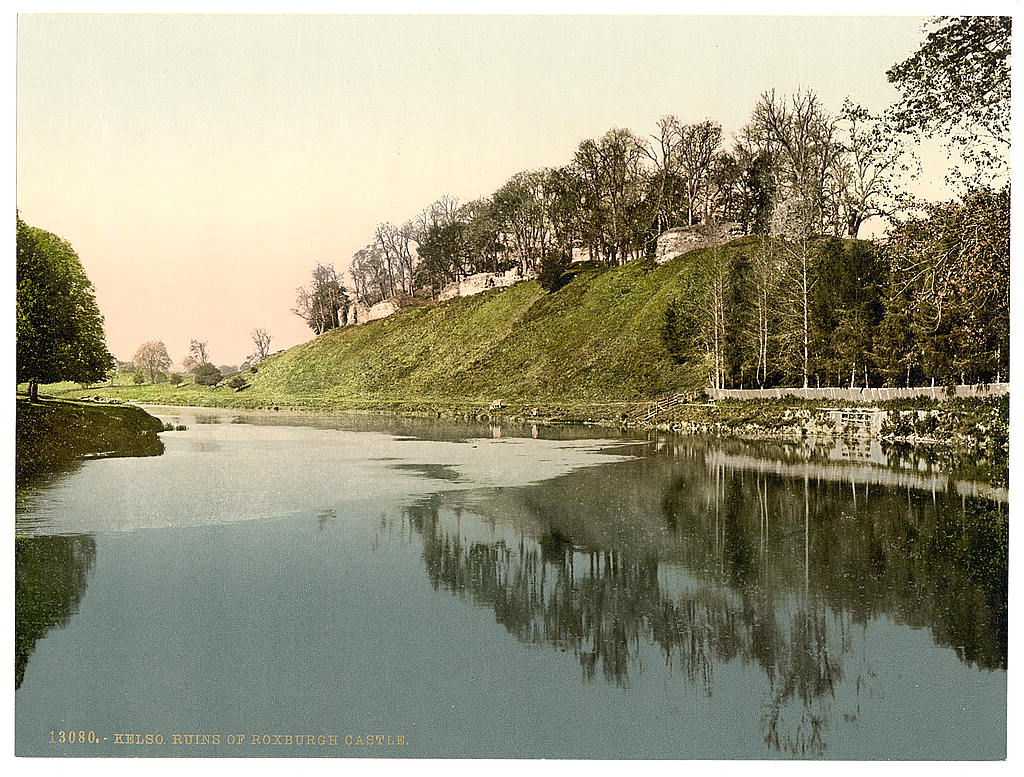
Above: Ruins of Roxburgh Castle, Kelso, Scotland, Between 1890 and 1900
Image Source = Library of Congress
Reproduction Number = LC-DIG-ppmsc-07621
Published by Detroit Publishing Company, 1905
+++++++++++++++++++++++++++++++++++++++++++++++++++++++++++++++++++++++++++
MARY LUNDIE DUNCAN (APRIL 26, 1814-JANUARY 5, 1840)
Scottish Presbyterian Hymn Writer
Mary Lundie, born in Kelso, Scotland,was a daughter of the Reverend Robert Lundie, a Church of Scotland minister. Her sister married Horatius Bonar (1808-1889), a great hymn writer. Our saint married the Reverend William Wallace Lundie (died in 1864), a Church of Scotland minster at Cleish, in 1836. Their marriage was brief, for she died in January 1840, after a chill turned into a fever. Our saint died a few months before her twenty-sixth birthday, leaving two young children behind.
The 1935 companion volume to the 1933 Presbyterian Church in the U.S.A. Hymnal says of our saint:
Mary Duncan was a most remarkable character. Her contemporaries compared her brilliant mind, overflowing personality, and devout spirit to those of Madame Guyon, the “evangelist of quietism.”
–pages 461-462
And Robert Guy McCutchan, in his 1937 companion volume to the 1935 Methodist Hymnal, wrote:
She was a beautiful woman with a beautiful character.
Here is an image of Mary Lundie Duncan I found at http://www.hymntime.com/tch/bio/d/u/n/duncan_ml.htm:
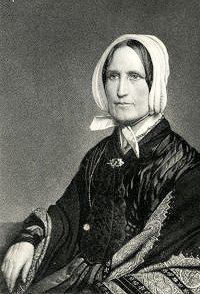
And here is a public domain image of Madame Jeanne Guyon (1648-1717):
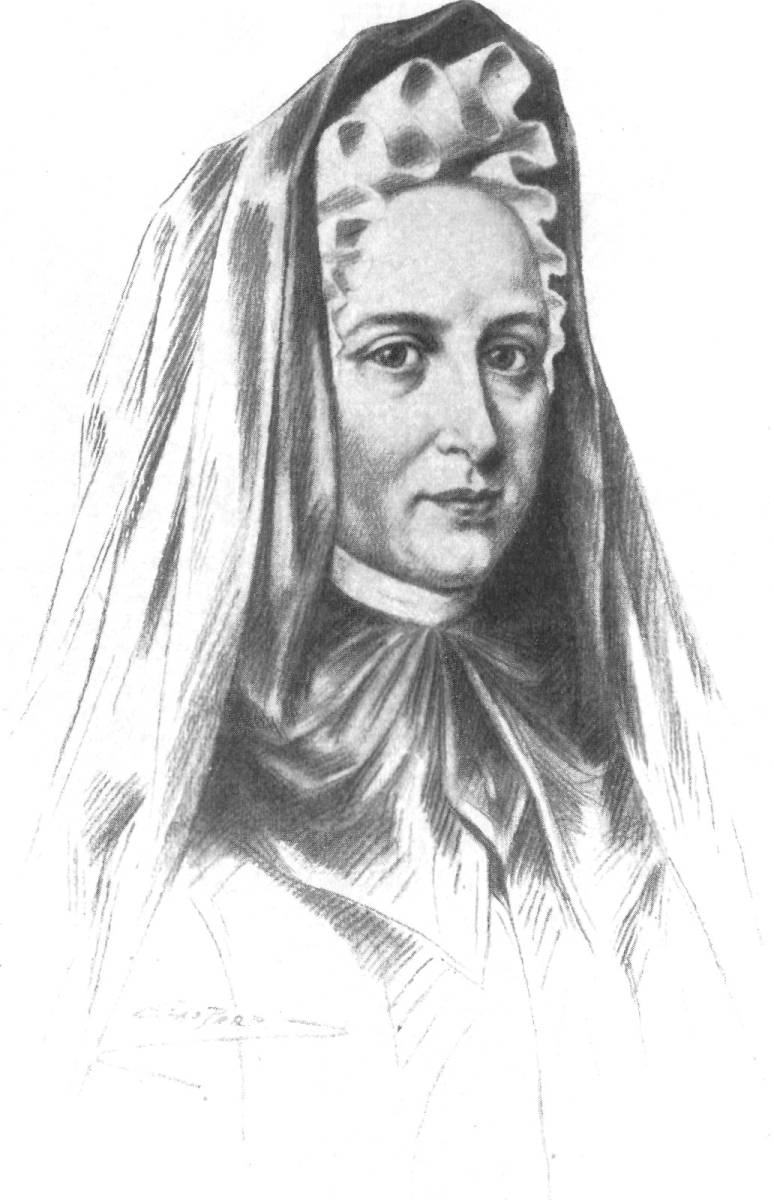
For more about Quietism, follow this link.
Our saint wrote hymns for her children from July to December 1839. Her mother had them published posthumously. Among those hymns was “Jesus, Tender Shepherd, Hear Me.”
Our saint’s widower participated in the 1843 Disruption which formed the Free Church of Scotland, which reunited with the Church of Scotland in 1929.
Mary Lundie Duncan lived well during the short span of her life. She devoted her life to God and loved her family. Fortunately for us, that legacy survives in hymnals.
KENNETH RANDOLPH TAYLOR
JULY 6, 2013 COMMON ERA
THE FEAST OF SAINTS VINCENTIA GEROSA AND BARTHOLOMEA CAPITANIO, COFOUNDERS OF THE SISTERS OF CHARITY OF LOVERE
THE FEAST OF ISAIAH, BIBLICAL PROPHET
THE FEAST OF JAN HUS, PROTO-PROTESTANT MARTYR
THE FEAST OF SAINT PALLADIUS, ROMAN CATHOLIC BISHOP
++++++++++++++++++++++++++++++++++++++++++++++++++++++++++++++++++++++++++++++++
Dear God of beauty,
you have granted literary ability and spiritual sensitivity to
Mary Lundie Duncan and others, who have composed hymn texts.
May we, as you guide us,
find worthy hymn texts to be icons,
through which we see you.
In the Name of God: Father, Son, and Holy Spirit. Amen.
Sirach/Ecclesiasticus 44:1-3a, 5-15
Psalm 147
Revelation 5:11-14
Luke 2:8-20
KENNETH RANDOLPH TAYLOR
APRIL 20, 2013 COMMON ERA
THE FEAST OF SAINTS AMATOR OF AUXERRE AND GERMANUS OF AUXERRE, ROMAN CATHOLIC BISHOPS; SAINT MAMERTINUS OF AUXERRE, ROMAN CATHOLIC ABBOT; AND SAINT MARCIAN OF AUXERRE, ROMAN CATHOLIC MONK
THE FEAST OF JOHANNES BUGENHAGEN, GERMAN LUTHERAN PASTOR
THE FEAST OF SAINT MARCELLINUS OF EMBRUN, ROMAN CATHOLIC BISHOP
THE FEAST OF OLAVUS AND LAURENTIUS PETRI, RENEWERS OF THE CHURCH
++++++++++++++++++++++++++++++++++++++++++++++++++++++++++++++++++++++++++++++++
Revised on November 21, 2016
++++++++++++++++++++++++++++++++++++++++++++++++++++++++++++++++++++++++++++++++
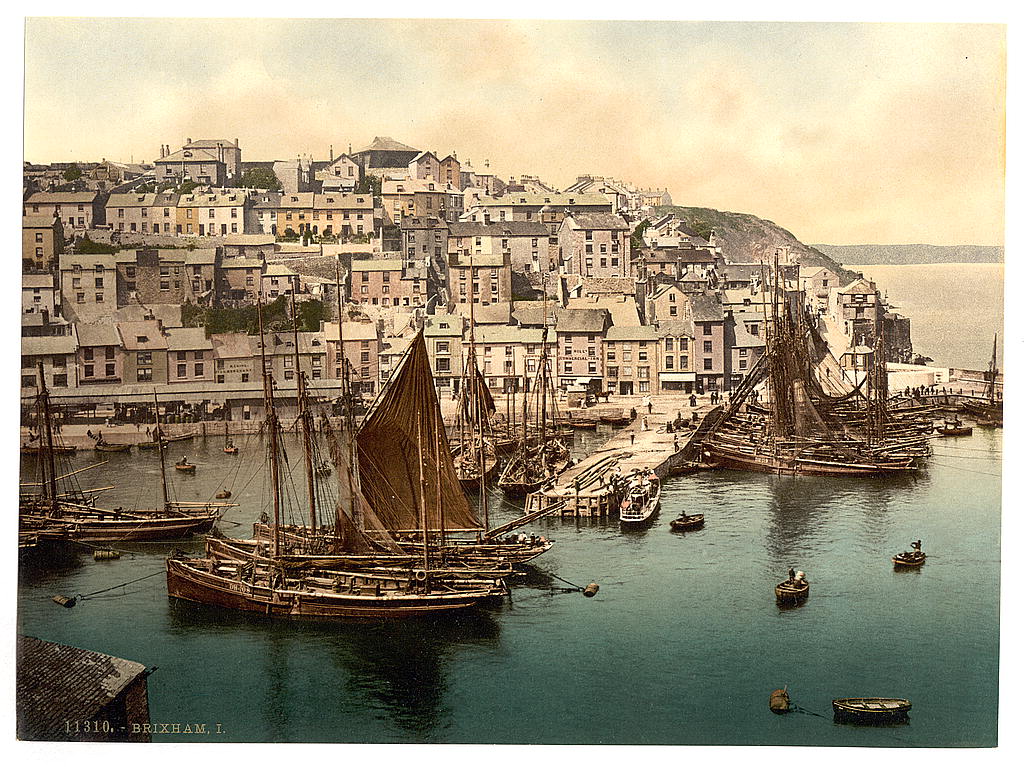
Above: Brixham, England, Between 1890 and 1900
Published by Detroit Publishing Company, 1905
Image Source = Library of Congress
Reproduction Number = LC-DIG-ppmsc-08056
++++++++++++++++++++++++++++++++++++++++++++++++++++++++++++++++++++++++++++
HENRY FRANCIS LYTE (JUNE 1, 1763-NOVEMBER 20, 1847)
Anglican Priest and Hymn Writer
Henry Francis Lyte, born at Ednam, Scotland, attended Trinity College, Dublin, where he won a poetry prize three times. He had planned originally to become a doctor yet chose instead to take Anglican Holy Orders. He served various congregations from 1815 to 1823. In 1818, at Marazion, Cornwall, our saint had an epiphany whereby what he already knew intellectually became real to him. Lyte sat by the death-bed of a fellow clergyman. Our saint wrote:
…He died, I rejoice to say, happy under the belief that though he had deeply erred, there was One whose death and sufferings would atone for his delinquencies, and be accepted for all that he had incurred. I was deeply affected for the whole matter, and brought to look at life and its issues with a different eye than before; and I began to study my Bible and preach in another manner than I had previously done.
–Quoted in Robert Guy McCutchan, Our Hymnody: A Manual of The Methodist Hymnal, 2d. Ed. (Nashville, TN: Abingdon Press, 1937, page 109)
From 1823 Lyte served as the Curate of Lower Brixham, Devon, a fishing village. This was a bad assignment for a man with a fragile constitution and a sensitive spirit, yet he worked there for a quarter of a century in the vineyard of the Lord. In 1847 our saint died at Nice, France, where he sought restoration and renewal. His last words were
Peace, joy!
as he pointed upward.
Lyte wrote the following:
- Tales on the Lord’s Prayer in Verse (1826);
- Poems, Chiefly Religious (1833); and
- The Spirit of the Psalms (1834).
I have provided the texts of some of Lyte’s hymns at my GATHERED PRAYERS blog.
When our end comes, O reader, may we, like Henry Francis Lyte, have a well-founded sense of peace and joy in God.
KENNETH RANDOLPH TAYLOR
JUNE 25, 2013 COMMON ERA
THE FEAST OF THE INAUGURATION OF THE UNITED CHURCH OF CHRIST, 1957
THE FEAST OF JAMES WELDON JOHNSON, POET AND NOVELIST
THE FEAST OF SAINT WILLIAM OF VERCELLI, ROMAN CATHOLIC HERMIT; AND SAINT JOHN OF MATERA, ROMAN CATHOLIC ABBOT
++++++++++++++++++++++++++++++++++++++++++++++++++++++++++++++++++++++++++++
Dear God of beauty,
you have granted literary ability and spiritual sensitivity to
Henry Francis Lyte and others, who have composed hymn texts.
May we, as you guide us,
find worthy hymn texts to be icons,
through which we see you.
In the Name of God: Father, Son, and Holy Spirit. Amen.
Sirach/Ecclesiasticus 44:1-3a, 5-15
Psalm 147
Revelation 5:11-14
Luke 2:8-20
KENNETH RANDOLPH TAYLOR
APRIL 20, 2013 COMMON ERA
THE FEAST OF SAINTS AMATOR OF AUXERRE AND GERMANUS OF AUXERRE, ROMAN CATHOLIC BISHOPS; SAINT MAMERTINUS OF AUXERRE, ROMAN CATHOLIC ABBOT; AND SAINT MARCIAN OF AUXERRE, ROMAN CATHOLIC MONK
THE FEAST OF JOHANNES BUGENHAGEN, GERMAN LUTHERAN PASTOR
THE FEAST OF SAINT MARCELLINUS OF EMBRUN, ROMAN CATHOLIC BISHOP
THE FEAST OF OLAVUS AND LAURENTIUS PETRI, RENEWERS OF THE CHURCH
+++++++++++++++++++++++++++++++++++++++++++++++++++++++++++++++
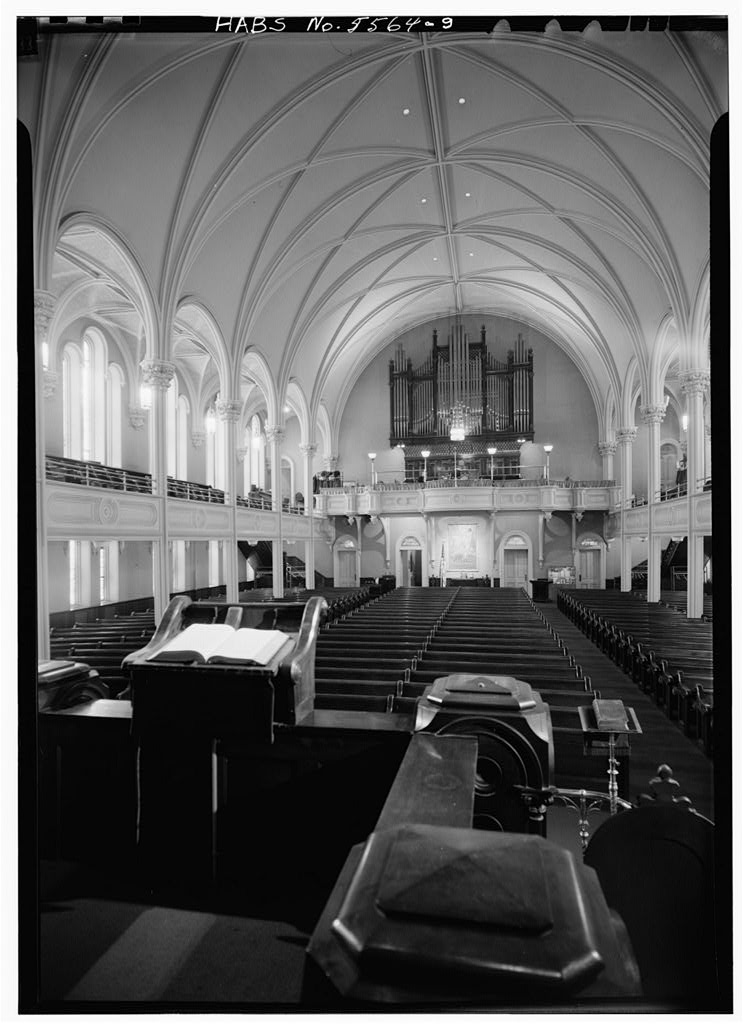
Above: Interior, Rear of the Church with the Organ Loft from the Altar, First Presbyterian Church, Binghamton, New York
Image Source = Library of Congress
Reproduction Number = HABS NY,4-BING,18–9
++++++++++++++++++++++++++++++++++++++++++++++++++++++++++++++++++++++++++++
LOUIS FITZGERALD BENSON (JULY 22, 1855-OCTOBER 10, 1930)
U.S. Presbyterian Minister and Liturgist
++++++++++++++++++++++++++++++++++++++++++++++++++++++++++++++++++++++++++++
Louis FitzGerald Benson was the son of a Philadelphia, Pennsylvania, businessman and elder at the Tenth Presbyterian Church. Our saint earned his Juris Doctor degree from the University of Pennsylvania then practiced law. After a few years, however, he perceived and followed a different vocation. So he enrolled at Princeton Theological Seminary. Benson, ordained the Presbyterian Church in the U.S.A. (1869-1958) in 1888, pastored one congregation, the Church of the Redeemer, Germantown, Pennsylvania, for six years. Then he embarked upon his true calling.
Benson became an Editor at the Presbyterian Board of Publication and Sabbath-School Work in 1894. He wrote and translated hymns, edited hymnals, and wrote about hymnody, becoming the foremost hymnodist in the United States during this lifetime and perhaps remaining unsurpassed after this death. He produced the following volumes:
- Selections from the Psalter for Use in the Services in the Churches (1895), as Co-Editor;
- The Hymnal (Presbyterian Church in the U.S.A., 1895), as Editor;
- The Hymnal for Congregational Churches (1897), as Editor;
- Hymns & Verses (1897), as Editor;
- The Chapel Hymnal (1898), as Editor;
- The Best Church Hymns (1898), as Editor; and its companion volume, Best Hymns, A Handbook (1898);
- The School Hymnal (1899), as Editor;
- The Convention Hymnal (1903), as Editor;
- The American Revisions of Watts’s Psalms (1903);
- Studies of Familiar Hymns (2 series, 1903 and 1923);
- The Book of Common Worship (Presbyterian Church in the U.S.A., 1906, as a co-editor with Henry Van Dyke;
- The Hymnal (Presbyterian Church in the U.S.A., 1911), as Editor;
- The Westminster Hymnal for Congregational and Social Use and for Sunday School (1911), as Editor;
- The English Hymn: Its Development and Use in Worship (1915);
- For Soldiers and Sailors: An Abridgement of the Book of Common Worship (1917), as Editor;
- For God and Country (1918);
- Hymns, Original and Translated (1925);
- Christian Song (1926); and
- The Hymns of John Bunyan (1930).
Our saint, a scholar of hymnody, had a 9,000-volume library.
Our saint shared the first draft of the following hymn, written on November 21, 1924, with his good friend, Henry Sloane Coffin. Coffin provided praise and constructive criticism, which influenced the final draft.
For the bread, which Thou has broken;
For the wine, which Thou hast poured;
For the words, which Thou hast spoken;
Now we give Thee thanks, O Lord.
+++++
By this pledge that Thou dost love us,
By Thy gift of peace restored,
By Thy call to heaven above us,
Hallow all our lives, O Lord.
+++++
With our sainted ones in glory
Seated at our Father’s board,
May the Church that waiteth for Thee
Keep love’s tie unbroken, Lord.
+++++
In Thy service, Lord, defend us;
In our hearts keep watch and ward;
In the world where Thou dost send us
Let Thy Kingdom come, O Lord.
As I researched our saint I found the following description of him at the Tenth Presbyterian website:
…the foremost hymnodist that America has produced.
I detect irony, for Benson was to the left of that congregation’s current theological position. He associated with the likes of Henry Sloane Coffin and Henry Van Dyke, liberals in their denomination. In 1981 Tenth Presbyterian Church affiliated with the Presbyterian Church in America (1973-), which is far to the right of Coffin, Van Dyke, and Benson.
Benson died at Philadelphia, his hometown, in 1930. On November 2 that year Dr. Henry Van Dyke, speaking at a memorial service for our saint, advised churches to cultivate the following, which were Benson’s ideals for hymns: cheerfulness, beauty, reverence, and spirituality. Van Dyke said that
When singing in all our churches has these marks, the joy of worship will revive and the churches will fill up.
–Quoted in Robert Guy McCutchan, Our Hymnody: A Manual of The Methodist Hymnal, 2d. Ed. (Nashville, TN: Abingdon Press, 1937, page 437)
Indeed, beauty and reverence in hymnody, combined with great substance thereof, is proper.
KENNETH RANDOLPH TAYLOR
JUNE 24, 2013 COMMON ERA
THE FEAST OF THE NATIVITY OF SAINT JOHN THE BAPTIST
+++++++++++++++++++++++++++++++++++++++++++++++++++++++++++++++++++++++
Holy God, whose majesty surpasses all human definitions and capacity to grasp,
thank you for those (especially Louis FitzGerald Benson)
who have nurtured and encouraged the reverent worship of you.
May their work inspire us to worship you in knowledge, truth, and beauty.
In the Name of the Father, and of the Son, and of the Holy Spirit. Amen.
1 Chronicles 25:1-8
Psalm 145
Revelation 15:1-4
John 4:19-26
KENNETH RANDOLPH TAYLOR
NOVEMBER 27, 2012 COMMON ERA
THE FEAST OF SAINT JAMES INTERCISUS, ROMAN CATHOLIC MARTYR
THE FEAST OF HENRY SLOANE COFFIN, U.S. PRESBYTERIAN THEOLOGIAN
+++++++++++++++++++++++++++++++++++++++++++++++++++++++++++++++++++++++
For Further Reference:
http://manuscripts.ptsem.edu/collection/25
+++++++++++++++++++++++++++++++++++++++++++++++++++++++++++++++++++++++
A Related Post:
http://blogatheologica.wordpress.com/2013/07/03/the-book-of-common-worship-revised-1932/
+++++++++++++++++++++++++++++++++++++++++++++++++++++++++++++++++++++++
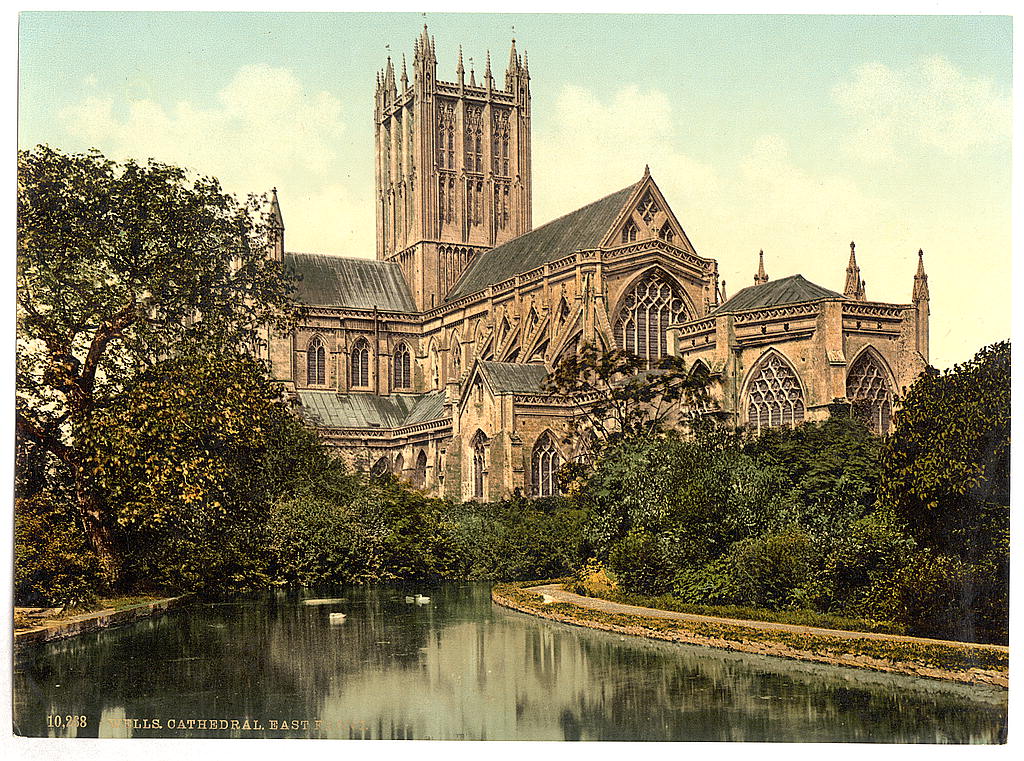
Above: Wells Cathedral, Between 1890 and 1900
Published by the Detroit Publishing Company
Image Source = Library of Congress
Reproduction Number = LC-DIG-ppmsc-08952
++++++++++++++++++++++++++++++++++++++++++++++++++++++++++++++++++++++++++++
GODFREY THRING (MARCH 25, 1823-SEPTEMBER 13, 1903)
Anglican Priest and Hymn Writer
The Reverend John Gake Dalton Thring, Rector of Alford, Somerset, England, and his wife, Sarah Jenkyns Thring, had a son, Godfrey Thring, in 1823. A previous son, Edward Thring, had arrived in 1821.
Edward was a remarkable person. He, ordained by The Church of England in 1846, served as the headmaster of Uppingham School from 1853 to 1887. He transformed it from a small, rural school into a large, public one. Edward also encouraged music education, considered one of his duties to be to identify what each student could do well, and wrote Theory and Practice of Teaching (1883) for young teachers. He was one of the leading English educators of his day.
Both Edward and Godfrey grew up in a household that taught them more of duty than of sentimentality. John Gale Dalton Thring wanted Godfrey to enter the Royal Army, but Sarah Jenkyns Thring, insisted upon the priesthood for her younger son. Godfrey obeyed his mother and fulfilled his duties with great care. He served a few congregations for the first twelve years of his priesthood. Then, in 1858, the Baillol College, Oxford-educated Godfrey succeeded his father as the Rector of Alford. He was a rural dean (1867-1876) then the Prebendary of East Harptree at Wells Cathedral (1876-1893).
Our saint made his primary contribution in the realm of hymnody. He wrote many hymns. He also compiled three hymnals:
- Hymns Congregational and Others; Hymns and Verses (1866);
- Hymns and Sacred Lyrics (1874); and
- A Church of England Hymn Book Adapted to the Daily Services of the Church Throughout the Year (1880); revised as The Church of England Hymn Book (1882).
Our saint’s 1880/1882 hymnal constituted a protest against the practice of factions within The Church of England publishing their own hymnals, thereby denying adherents of other factions certain hymns. The 1880/1882 hymnal also established a new, higher literary standard for English hymnals. It favored quality of words over rampant Victorian sentimentality.
I got the impression from reading the brief biography of our saint in Robert Guy McCutchan, Our Hymnody: A Manual of The Methodist Hymnal, 2d. Ed. (Nashville, TN: Abingdon Press, 1937) that McCutchan preferred more sentimentality than did Godfrey Thring. But there is such a thing as excessive sentimentality.
In a letter Edward Thring told his brother, our saint:
Be sure that no painting, no art work you could have done, by any possibility could have been so powerful for good, or given you the niche you now occupy. As long as the English language lasts, sundry of your hymns will be read or sung, yea, even to the last day, and many a soul of God’s best creatures thrill with your words. What more can a man want? Very likely, if you had all the old heathendom rammed into you, as I had, and all the literary artists slicing and pruning, and had been scissored like me, you would have lost the freshness and simple touch which make you what you are. No, my boy, I make a tidy schoolmaster and pass into the lives of many a pupil, and you live on the lips of the Church. So be satisfied. And what does it matter, if we do the Master’s work?
–Quoted in Robert Guy McCutchan, Our Hymnody (1937), 70
Godfrey Thring occupied a fine niche in the Church.
KENNETH RANDOLPH TAYLOR
JUNE 12, 2013 COMMON ERA
THE FEAST OF EDWIN PAXTON HOOD, ENGLISH CONGREGATIONALIST MINISTER, CONGREGATIONALIST, AND HYMN WRITER
THE FEAST OF EMMEGAHBOWH, EPISCOPAL PRIEST
THE FEAST OF SAINT FREDERICK OF UTRECHT, ROMAN CATHOLIC BISHOP AND MARTYR; AND SAINT ODULT OF UTRECHT, ROMAN CATHOLIC MISSIONARY PRIEST
++++++++++++++++++++++++++++++++++++++++++++++++++++++++++++
Eternal God, light of the world and Creator of all that is good and lovely:
We bless your name for inspiring Godfrey Thring
and all those who with us have filled us with desire and love for you;
through Jesus Christ our Savior, who with you and the Holy Spirit
lives and reigns, one God, for ever and ever. Amen.
1 Chronicles 29:14b-19
Psalm 90:14-17
2 Corinthians 3:1-3
John 21:15-17, 24-25
–Adapted from Holy Women, Holy Men: Celebrating the Saints (2010), page 728
++++++++++++++++++++++++++++++++++++++++++++++++++++++++++++
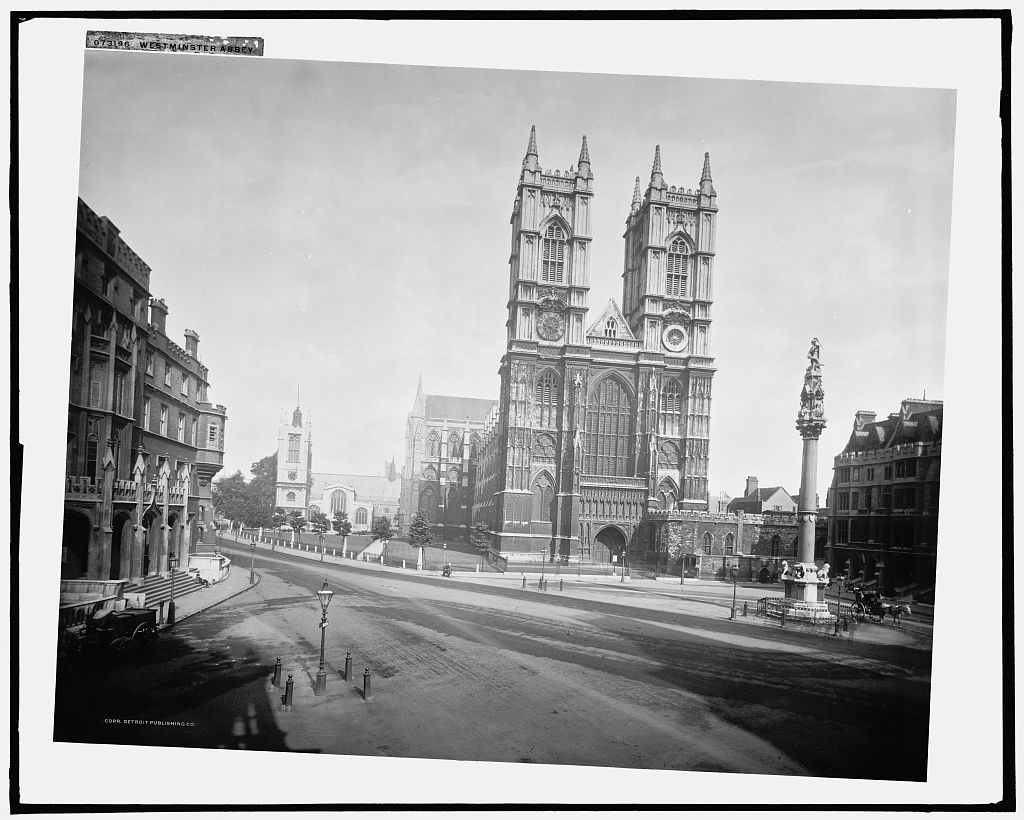
Above: Westminster Abbey, Between 1910 and 1920
Copyright Claimant = Detroit Publishing Company
Image Source = Library of Congress
Reproduction Number = LC-D4-73196
+++++++++++++++++++++++++++++++++++++++++++++++++++++++++++++++++++
WILLIAM CROFT (BAPTIZED DECEMBER 30, 1678-DIED AUGUST 14, 1727)
Anglican Organist and Composer
William Croft was one of the greatest composers of English church music. He wrote hymn tunes (including “St. Anne,” the tune for “O God, Our Help in Ages Past;” and Hanover, the tune for “Ye Servants of God, Your Master Proclaim”), services, odes, anthems, and sonatas–even some incidental music–and influenced the cantatas of George Frederick Handel. Croft’s Musica Sacra (1724) contained thirty of his anthems and his setting of the burial service from The Book of Common Prayer (1662).
Croft’s musical career began in the Chapel Royal, where, when he was quite young, he sang in the choir. Later he became a church organist–first at St. Anne’s Church, Soho; then at the Chapel Royal (1704-1708, jointly with Jeremiah Clark through 1707); then at Westminster Abbey, beginning in 1708. Croft divided his time between Westminster Abbey and the Chapel Royal, where he was a composer. And Oxford University bestowed the Mus.Doc. degree upon him in 1713.
Croft died of an illness
occasioned by his attendance on his duty
at the coronation of King George II (reigned 1727-1760). Our saint’s epitaph reads in part:
In his celebrated works, which for the most part he dedicated to God, he made a diligent progress; nor was it by the solemnity of the numbers alone, but by the force of his ingenuity; and the sweetness of his manner, and even his countenance, he excellently recommended them. Having resided among mortals for fifty years, behaving with the utmost candor (not more conspicuous of any other office of humanity than a friendship and a love truly fraternal towards all whom he instructed), he departed to the heavenly choir,…that, being near, he might add his own Hallelujah to the concert of angels.
–Quoted in Robert Guy McCutchan, Our Hymnody: A Manual of The Methodist Hymnal, 2d. ed. (Nashville, TN: Abingdon Press, 1937, page 217)
I, as a lover of refined church music, appreciate William Croft’s contributions to the field.
KENNETH RANDOLPH TAYLOR
MAY 25, 2013 COMMON ERA
THE FEAST OF NICOLAUS SELNECKER, GERMAN LUTHERAN MINISTER, THEOLOGIAN, AND HYMN WRITER
THE FEAST OF SAINT ALDHELM, ROMAN CATHOLIC BISHOP
THE FEAST OF SAINT MADELEINE SOPHIE BARAT, MOTHER SUPERIOR OF THE SOCIETY OF THE SACRED HEART
THE FEAST OF VENERABLE BEDE OF JARROW, HISTORIAN AND ROMAN CATHOLIC MONK
+++++++++++++++++++++++++++++++++++++++++++++++++++++++++++++++++++++++
Eternal God, light of the world and Creator of all that is good and lovely:
We bless your name for inspiring William Croft and all those
who with music have filled us with desire and love for you;
through Jesus Christ our Savior, who with you and the Holy Spirit
lives and reigns, one God, for ever and ever. Amen.
1 Chronicles 29:14b-19
Psalm 90:14-17
2 Corinthians 3:1-3
John 21:15-17, 24-25
–Adapted from Holy Women, Holy Men: Celebrating the Saints (2010), page 728


















You must be logged in to post a comment.